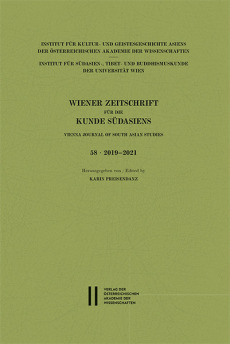Wiener Zeitschrift für die Kunde Südasiens, Band 58 (2019‒2021) ‒ Vienna Journal of South Asian Studies, Vol. 58 (2019‒2021)
Reihe herausgegeben von Birgit Kellner, Herausgegeben von Karin Preisendanz
The “Wiener Zeitschrift für die Kunde Südasiens / Vienna Journal of South Asian Studies” was founded in 1957 by Erich Frauwallner. The journal was then published jointly by the Department of Indology (Institut für Indologie) of the University of Vienna and the Committee for the Languages and Cultures of South and East Asia (Kommission für Sprachen und Kulturen Süd- und Ostasiens) of the Austrian Academy of Sciences, which was the forerunner of the present-day Institute for the Intellectual and Cultural History of Asia (Institut für die Kultur- und Geistesgeschichte Asiens, founded in 1991) and had been established at Frauwallner”s initiative in 1956. From the year 2000 onwards, the Department of South Asian, Tibetan and Buddhist Studies functions as the co-publisher at the University.
In its general part, this volume contains three papers. R. H. Koch studies the representation of the popular Cullapaduma-Jâtaka, on the basis of its Singhalese Jâtaka version, in murals preserved in various Sri Lankan Buddhist monasteries, with reference to its contemporary representation in other art forms. The two papers by E. Franco and J. Soni contribute each in its own way to our knowledge of the history of pre-modern South Asian Studies. In his review article of Lardinois’ 2018 book on Sylvain Lévi and the introduction of Sanskrit into the Collège de France, Franco treats the early history of Sanskrit Studies at the Collège and its representation by Sylvain Lévi, and provides valuable information on the papers of Antoine-Léonard Chézy which until recently were thought to have been lost. On the basis of a collection of letters addressed by European and American scholars to the Jain monk and scholar Vijayendra Sūri, which was published in 2016, Soni explores and elucidates the history of the intense and fruitful interaction between them.
The second part, the Archiv für indische Philosophie, contains another three papers. Starting from references in the writings of the Chinese translator and scholar Xuanzang (7th c.) and his interpreters, J. Chu examines the doctrinal position of the accompaniment of sensory awareness by mental awareness attributed by them to the sixth-century Indian scholar Sthiramati in his own works and in other foundational Yogâcâra literature. Based on the Yuktidîpikâ and with much attention to philological detail, Th. Oberlies treats the complex concept of creation in early Sâṅkhya in its relation to meditation and the liberating insight of Sage Kapila. In her review article on Verpoorten’s 2018 translation of the section on perception in the Pramâṇapârâyaṇa of the Prakaraṇapañcikâ, E. Freschi also offers background information on the Mîmâṃsâ scholar Úâlikanâtha and an annotated philosophical–historical survey of the complete first chapter of his Pramâṇapârâyaṇa.
The third part features twenty-six reviews of books on a wide range of topics relating to the cultural and intellectual history of South Asia and on the history of pre-modern South Asian Studies.

